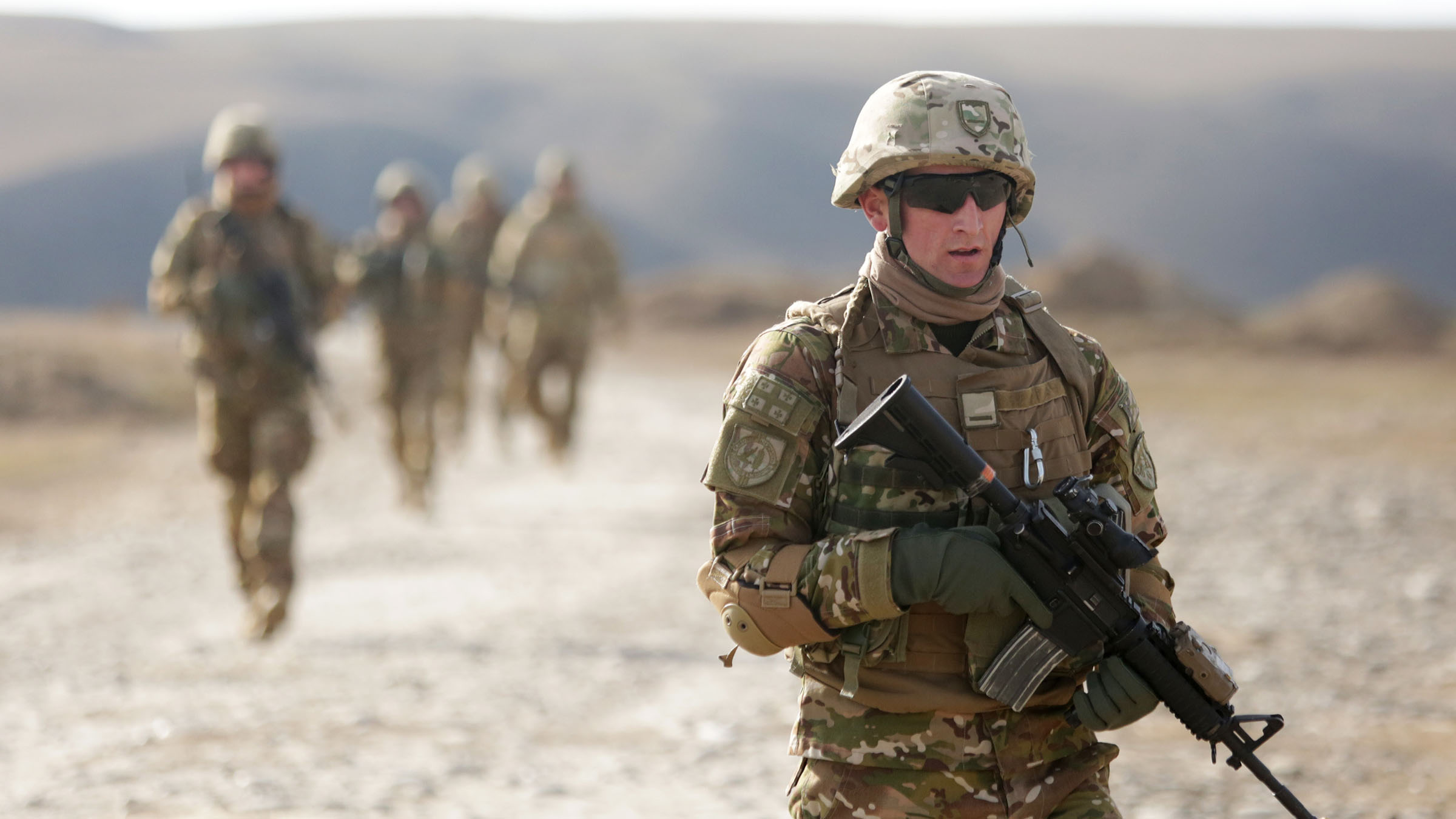JOHN HARTIGAN looks at one of the mightiest obstacles to a peaceful world – the massive international arms market …
THE MILITARY SUPERMARKET – OPEN ALL HOURS
Is a future golden age of peace still a far-fetched dream? If the world’s 64 current wars continue to rage, if the 110 million active landmines hidden in the earth continue to kill and main innocent people, and if the multi-billion dollar weapons industry continues to revolutionise technologies of death, then a peaceful future will probably never exist.
“Every gun that is made, every warship launched, every rocket fired signifies, in the final sense of theft from those who hunger and are not fed, those who are cold and are not clothed. The world in arms is not spending money alone. It is spending the sweat of its labourers, the genius of its scientists, the hopes of its children.this is not a way of life at all in any true sense. Under the cloud of threatening war, it is humanity hanging from a cross of fire.”
– Dwight Eisenhower, US President 1953-1961
EXPLOSIVE MARKETS
It’s sadly ironic that a former US president’s perceptive statement is so contradictory to the attitudes of America’s incumbent president. Yet as the decades have passed since Eisenhower made that statement, America will still lead the world in the weapons arms race. In 2002 it’s estimated that US$9 trillion has been spent on nuclear weaponry since 1945 – that equates to approximately US$1.5 million every minute. The consequences in terms of human suffering are incalculable, in simple terms the death toll is placed at 35 million people. In 1995 world military expenditure on conventional weapons was a staggering US$591,854,000,000 according to the Stockholm International Peace Research Institute (SIPRI). By next year that figure will have has risen to US$739,806,250,000 or US$107.53 for every man, woman and child alive today. The figures alone are daunting, but when taken in conjunction with the cost of diverting economic resources from peace to weapons, the figures are not obscene, but cast grave doubts on the sanity of world leaders.
Eisenhower is only one of the numerous people in history who, having experienced war and its terrible effect on humanity, so eloquently criticised it.
In her excellent book ‘the March of Folly’, American historian Barbara W Tuchman opens with profound words: “A phenomenon noticeable throughout history regardless of place or period in history is the pursuit of governments of policies contrary to their own interests.” The English historian, Eric Hobsbawn, writes: “Since this century has taught us, and continues to teach us, that human beings can learn to live under the most brutalised and intolerable conditions, it is not easy to grasp the extent of the, unfortunately accelerating return to what our nineteenth-century ancestors would have called the standards of barbarism.” ‘Land Mines Friend or Foe’, a study authored by former British Brigadier Patrick Blagden, looked at the hideous consequences of anti-personnel mines. Blagden said in thirty years as an army officer, he hadn’t considered the consequences of this form of weaponry. It was only later, as a clearance adviser to the UN, that he witnessed the lasting legacy these mines have. At a cost of between $300 and $1000 to remove each mine, it’s simply impractical for many third world countries to eradicate them. Especially when they can be bought on the black market for around $10 each. The US Red Cross estimates 800 people a month are killed by stepping on mines, and there is no respite because land mines have no ‘use by date’
WARFARE AND THE HUMAN MIND
War doesn’t just take a physical toll. Psychological research shows that the horrors of war remain in the mind as a psychological legacy, lying there like an unexploded landmine. ‘It’s estimated that from World War Two onwards, approximately 30% of battlefield casualties have been psychiatric casualties,” says Dr Harry Cohen, president of the Australian Medical Association for the Prevention of war. “Our species, in spite of what some may think, is not suited to inflicting and witnessing violence and suffering. In the Vietnam War over 50,000 US soldiers were killed. Since then 100,000 Vietnam veterans are thought to have committed suicide. We can now add to those from the Vietnam War, soldiers who have been involved in two Gulf Wars, Bosnia, Afghanistan, Chechnya, East Timor and a host of so-called police actions.
If we accept Dr Cohen’s viewpoint, that war and conflict is not a natural activity for humans, but rather it is an aberrant form of behaviour that rears its head as a result of social, physical and psychological stresses, we must also accept that apart from the 50 million soldiers and civilians killed in the last fifty years, and the multiple effects on the survivors, the international modern military is inevitably leading us to Eric Hobsbawn’s Standards of Brutality.
Wars are historically fought for a range of complex reasons – power, perceived security, greed and provocation. Today, many people see all of the above inextricably entwined in a battle for trade domination.
Despite all the advances of humankind the prevention and pre-emption is still a distant dream. While world social needs go unmet, the nuclear military machine moves inexorably onwards – devouring another US$1.5 million a minute.
Promoting the reduction in war, analysts predicate that one of the key areas to encourage peace is in meeting the needs of children. This they claim will reduce community stress of providing for their children, by educating tomorrow’s leaders, and by offering a sense of hope for the future.
A report by the United Nations Children’s Fund, published three years ago stated that the future of the world’s children would be more secure if military expenditure was cut by a mere three percent a year. The ‘State of the World’s Children’ report claimed the cut would give developing and industrialised nations $460 billion to spend on better education, health and welfare for their youth in the next decade. The report continued with the premise that we need to kindle a sense of absurdity at the idea that the world cannot afford to meet the needs for all children for adequate nutrition, basic health care, primary education and clean water.
ESTIMATED COSTS FOR MEETING WORLDWIDE NEED FOR :
BASIC CHILD HEALTH:
$17 BILLION
PRIMARY EDUCATION:
$8.6 BILLION
SAFE WATER/SANITATION:
$12.5 BILLION
FAMILY PLANNING:
$8.6 BILLION
ESTIMATES OF WORLDWIDE SPENDING ON:
GOLF $59 BILLION
WINE $118 BILLION
ADVERTISING $380 BILLION
MILITARY $590 BILLION
THIRD WORLD BUYERS
A better way to invest in peace other than the option of more guns is the support of Third World nations in achieving genuine independence and political stability. At present it could be argued that Western nations have a vested interest in keeping these countries suppressed and subservient, ensuring they ‘re continually available as a source for rich nations development. Labour, resources, tourism, and the arms trade. Western Nations need the subjugation of Third World countries to maintain their extravagant lifestyles. America, comprising approximately 5 percent of the world’s population, consumes 40 percent of world resources. Europe and Oceania (15 percent of the world’s population) eats up another 40 percent. Leaving the remaining 80 percent of the world’s population to squabble over the remaining 20 percent.
The West feeds on the misfortune of disempowered countries. Countries at war keep the voracious arms industry afloat and ensure there’s a dumping ground for yesterday’s weaponry. Victor W Sidel looked at this side of the issue in an article entitled ‘The International Arms Trade and its Impact On Health’.
“Virtually all wars since 1945 have been fought in Third World countries, often as surrogate wars between America and her perceived enemies,” Sidel wrote. “More recently civil wars, often based on historic ethnic enmities, opposition to oppressive governments, or arising from artificial geographic boundaries created by colonial powers, have created the greatest number of casualties.”
THE HUMAN DEVELOPMENT COST OF ARMS TRADING
Money spent on defence is a trap; it keeps people in fear and ignorance, retards their ability to think clearly and globally, creates mistrust with other countries and denies ordinary people money for real economic growth. Many countries continue to import expensive weapons, even though they have a long list of more essential items. This is clear from the arms deliveries and orders in the categories covered by the UN’s arms register. Some of the choices made by developing countries in 1992:
CHINA – purchased 26 combat aircraft from Russia in a deal whose total cost could have provided safe water for one year to 1450 million people now without safe water.
INDIA – ordered 20 MiG 29-fighter aircraft from Russia at a cost that could have provided basic education to all 15 million girls out of school.
IRAN – bought two submarines from Russia at a cost that could have provided essential medicines to the country several times over – 13 percent of Iran’s population has no access to health care.
REPUBLIC OF KOREA – ordered 28 missiles from America for an amount that could have immunised all the unimmunised 120,000 children and provided safe water for three years to 3.5 million people.
MALAYSIA – ordered two warships from the UK at a cost that could have provided safe water for 25 years to its people.
Since 1992 American companies have sold Iraq $75 millions worth of materials for building nuclear power stations, as well as billions of dollars worth of arms to Israel. France continued its trade with Iraq and Iran in selling both nuclear components and military hardware. Britain has sold Indonesia fighter planes and gunships. Western nations are still selling weapons of every description to most Third World countries – and the sales continue to increase in volume.
AUSTRALIA’s military figures as shown in SIPRI and confirmed in recent Federal Budget numbers are; $11, 027 million, or nearly $600 per person. Australia’s attitude toward defence is demonstrated by the fact that in the same budget papers:
Environmental protection receives $160 million, or $8.42 per person.
National disaster Relief $58 million, or $3.05 per person.
Human Rights and Equal Opportunity $12 million, or 63 cents per person.
National Youth suicide Studies, $4.8 million, or 25 cents per person.
Just a ten percent reduction in current military spending in a decade could largely wipe out our foreign debt, ending the present cuts to education, health, welfare and other social programs.
THE MARKET LEADERS IN WEAPON SALES
Who are the manufacturers? Lockheed (USA) heads this illustrious list. Of the company’s near $30 billion in sales, 63 percent is earned by arms sales. After Martin McDonnell Douglas (USA) comes British Aerospace earning $7730 million in the sale of weapons. General Motors are fourth generating $6200 million, while Boeing (USA) earns $4640 million from the machinations of war. Included in this hall of shame are such familiar names as DaimlerBenz, General Dynamics. GEC, Westinghouse Electric, Mitsubishi, Rolls Royce, Unisys and Kawasaki.
THE FUTURE IS UP TO YOU
In the next ten years it’s estimated another US$ 101,482,233,000,000 will be spent on conventional weapons alone. On the nuclear front, the United States will be spending $50 billion on research and development on new nuclear weapons technology in the next decade and plans to conduct ‘subcritical nuclear testing’ in the Nevada Desert this year. With no pretence at subtlety America has announced it plans to produce mini-nukes as standard weapons for its conventional ground forces. Meanwhile India and Pakistan continue with their own plans for nuclear weaponry as a deterrent against each other they say. North Korea ignores the Nuclear Non Proliferation Treaty, Israel keeps its arsenal of around 100 nuclear bombs dusted off ready for action, their neighbours in Iran are quietly going about developing their own arsenal of destruction, and Russia is open shop to anyone who wants to buy its nuclear left overs.
Currently there are around 37,000 nuclear weapons worldwide. Unless the nuclear weapons states commit to reducing their stockpiles to zero, the threat of a renewed nuclear arms race is imminent.
Australia took a leading stance in both the Chemical Weapons Convention and the Comprehensive Test Ban Treaty. Pushing for a general nuclear ban is the logical next step, but it’s only the beginning.
We must take up the challenge against the perpetrators of the warmongering mentality – those who produce and market weapons of war.
John Hartigan is a Perth-based freelance writer who welcomes your correspondence. Email him via hartigan@iinet.net.au
For more background articles and relevant links click here.














